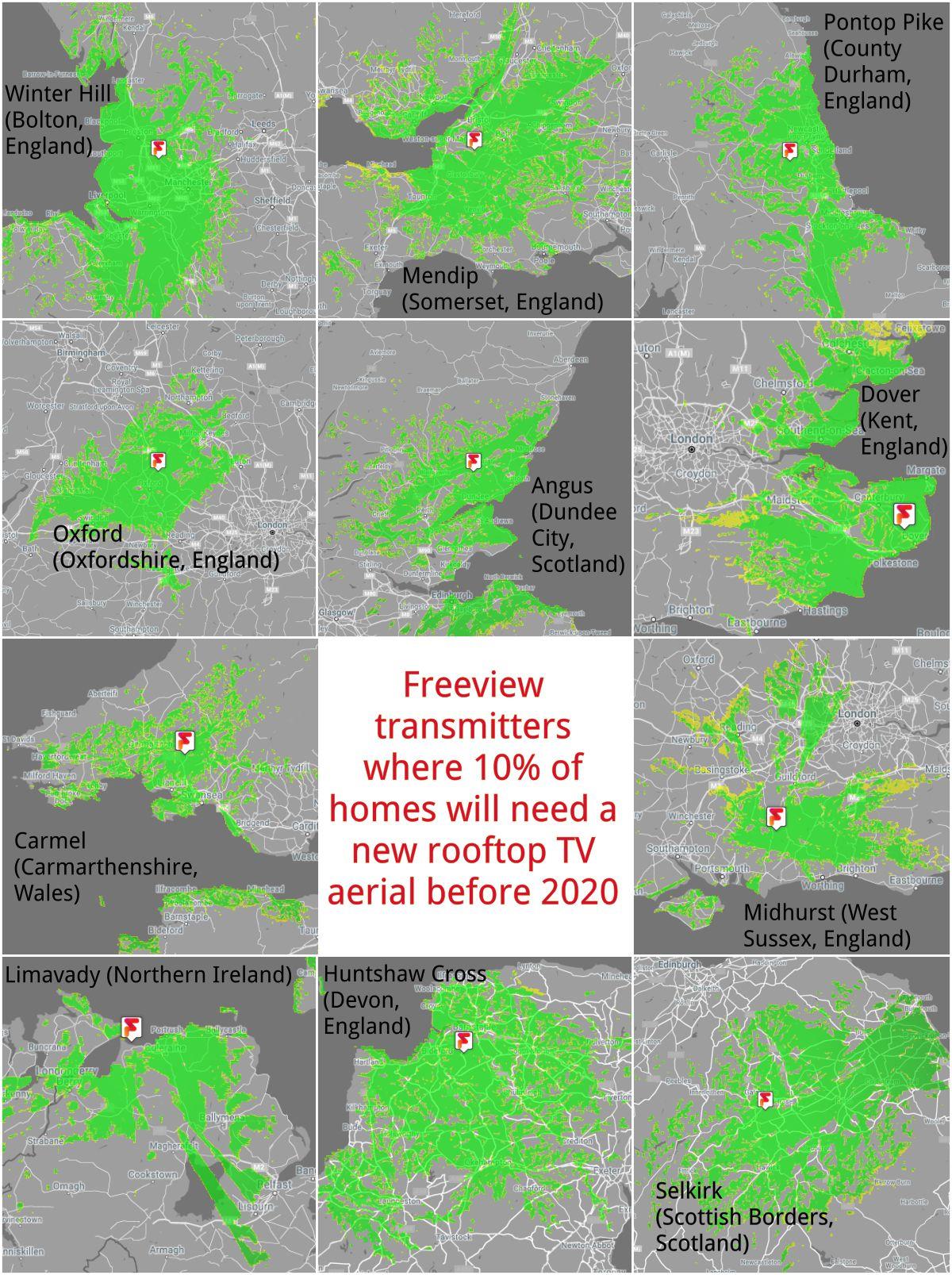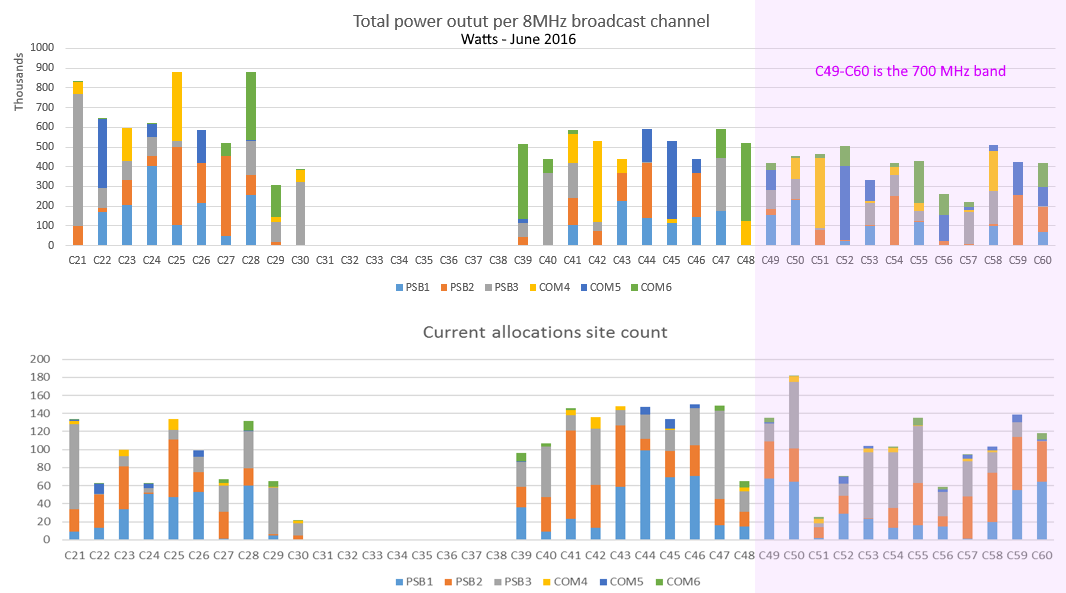When will I get a new Freeview aerial because of even more mobile broadband?

What is 700MHz clearance?
Back in 2012, the UK completed the switch to digital-only TV to provide greater viewing choice, high definition channels, improved reliability and better picture quality.
Digital TV makes much more efficient use of the UHF broadcast frequencies. This has meant that nine old frequencies used by TV (C61 to C69) could be sold to Three, EE, Vodafone and O2 for use by mobile phones to access the internet at higher speeds than before.

The ever-growing demand for mobile internet - that works reliably when traveling, inside shops and offices - means that Freeview will need to vacate more broadcast channels (C49 to C60) in about four years’ time.
This can be done without reducing the available TV and radio channels, but it will mean retunes for all Freeview viewers – and new TV aerials for about 10% of homes in Greater Manchester, Cheshire, Merseyside, Somerset, Bristol, County Durham, Oxfordshire, Dundee, Dover, Carmarthenshire, West Sussex, North Devon, the Scottish Borders and the north of Northern Ireland. These new aerials will be provided and fitted for free.
Things that we know
We know that Ofcom and the government are committed to allocating the former TV broadcast frequencies in the 700MHz band to mobile broadband from 30 June 2020:
- The date for the start of use for 694 MHz and 790 MHz for mobile broadband in the Pan-European frequency allocation area is 30 June 2020.
- There is insufficient capacity for the interim multiplexes to continue past 30 June 2020 and they will close on or before this date;
- The interim multiplexes will shift to using Single Frequency Network (SFN) on two “700MHz” frequencies –
probably channel C51C55 and C56 at some point between now and 2020. This will be the “first clearance event” and cause some homes to change aerial groups. - At some point each of the transmitters using the “700MHz” channels – that’s C49 to C60 – will need to find the homes without wideband aerials and have them fitted. There may be a large number to deal with in Manchester and Oxfordshire.
- C38, which is currently allocated to PMSE – which is mainly “stage” radio microphones and short-distance video outside broadcast links – will need to be used for Freeview. Due to the nature of the industry, this channel may not come available to Freeview until 2020. This might mean a final “clearance event” on this date.
- Once the mobile broadband services start, homes using C47 and C48 for Freeview in weak Freeview signal areas with masthead amplifiers will need to be dealt with (like “at800”), starting in July 2020.
- The 700MHz band consists of twelve UHF channel numbers, but there are only seven in the 600MHz band, and one used for PMSE. This means that the mapping of frequencies won’t be a simple matter as there will be four less classical Freeview allocations for the same service.
How are the current Freeview broadcast frequencies used?
The interim multiplexes will shift to using Single Frequency Network (SFN)
This is going to be an issue for homes in some transmitter areas that watching the “extra” Freeview HD channels on the two temporary multiplexes called com7 and com8 – which shows these Freeview channels:
57 VIVA, 67 CBS Reality +1, 71 CBS Drama, 78 5USA +1, 81 Talking Pictures TV, 86 Vintage TV, 87 Keep It Country, 106 BBC Four HD, 107 BBC News HD, 108 Al Jazeera English HD, 109 Channel 4+1 HD, 110 4seven HD, 113 RT HD, 124 CBeebies HD, 134 Al Jazeera Arabic, 77 Rishtey Europe, 245 Keep It Country TV 111 QVC +1 HD, 112 QVC Beauty HD
...and are using a “group A aerial”. Most homes have long-since switched to using a wideband aerial, but if you haven’t and live in these places you might not be able to watch the above channels after com7 and com8 change frequencies:
Greater London, Lincolnshire, Cumbria, Isle of Wight, Sussex and Hampshire coast, North Yorkshire, Aberdeenshire, eastern Northern Ireland, Cornwall, Fife, Herefordshire, East Ayrshire, South Yorkshire, Newcastle and Stoke-on-Trent.
Program-Making and Special Events - PMSE
If you run a professional performance venue (for concerts or theater) or make TV (live or recorded) shows you will probably make use of radio microphones or short-distance links for audiovisual. Before 2012 you will have been using “C69” for these, and had to have the equipment changed to C48.
Because Freeview is going to work with twelve less broadcasting channels from 2020, it will be necessary to use C48 for Freeview. Also many TV studios (say, Sky News) also make use of unused Freeview channels for radio microphones and they simply won’t be able to find unused channels from mid-2020.
Ofcom has provided PMSE new frequencies away from the old TV ones, but this will mean another equipment upgrade as well as using digital technology to make better use of the new band.
Where the new 4G services overload Freeview homes
Since the start of the previous 4G services, a very small number of Freeview viewers have had to fit “filters” or have had their rooftop aerial amplifier removed. This was done by “at800” who provided any home with the necessary equipment for free.
The same scheme will be run for those people now in the top band, which is about 1% of Freeview homes, which will then run from July 2020 onwards, presumably as “at700”.
What is the schedule for these changes?
There are several good reason for leaving the changes until as late as possible: newer Freeview equipment is able to re-tune when network changes happen, and it will take time to locate the actual aerials that will need replacing.
The first event will need be a “national retune” for Freeview HD users and those places using C51 (Emley Moor, Dover, Sandy Heath, Redruth, Beacon Hill and others) C55 and C56 (Mendip, Sudbury, Waltham, Huntshaw Cross) effected by the movement of com7 and com8 to a national SFN.
The 2009-2012 digital switchover process suggests that rest of the process will be done on a region-by-region basis. This time it might be....
Scottish Borders, South West, Northern Ireland, South, Wales, South East, East Scotland, South (Oxford), North East and Cumbria, West and then North West
No changes will be needed at Cambridge, Channel Islands, East, East Midlands, East Yorkshire and Lincolnshire, London, the rest of Scotland, West Midlands and Yorkshire.
Further reading
- Ofcom: Rooftop TV Aerial Performance 2016
- Ofcom: Consumer aerial survey 2014
- Parliament: Digital Single Market: Use of the 470–790MHz Radio Spectrum band, 2016
- Parliament: Power for Ofcom to align Multiplex (Mux) and Public Service, 2013
- Communications Consumer Panel and ACOD response, 2016
- DUK/Arqiva/BBC/C4/ITV Managing the effects of 700MHz clearance, 2016
- BBC R&D Coexistence between LTE and DTT, 2015
- Ofcom Managing the effects of 700 MHz clearance on PMSE and DTT viewers, 2016
6:11 PM
Marc Hall:
The owner of the blocks is responsible for the aerial systems. If that was the local council and they have sold off the flats to individuals, then they have created a problem for themselves and the residents. There are planning laws concerning how many aerials amd/or dishes can be fitted to a building. Generally speaking, the whole building is only allowd to have a total of two units, either aerials or dishes or one of each.
So you need to discuss with your neighbours in the privately ownbed flats how you are going to resolve the issue.
You may find the information given at Planning Permission: General information | Satellite,TV and radio antenna | Planning Portal to be a useful starting point.
| link to this comment |
12:34 PM
700MHz clearance and its implications.
Are all transmitters' new channels already published?
Due to marginal signal strengths, I would be happy to replace
my current log with a future-proof and more efficient yagi.
Ofcom announced that G3/G4 boosters will be legalised in early 2018.
Is information on the implementation of this available?
This will be invaluable for locations currently without a mobile phone signal -
and profitable for new service provision in the vacated 700MHz band.
These relatively lower frequencies will mean that the rx/tx aerials inside
hand-held equipment will be even shorter compared to wavelength, and
therefore less efficient. Consequently coverage in current mobile fringe areas
may still be patchy. However new, relatively lower, frequencies
used will "bend" into the topography slightly better than, say 1800MHz.
Overall, we should (sic!) enjoy a better service.
| link to this comment |
1:56 PM
My Dad is in a home in Old Bosham, West Sussex and is having trouble with his TV reception via the Home's aerial system (with and without an amplifier). Should he switch to an indoor aerial (wide-band) and re-tune or is there some other simple steps to take to stop the weaker channels from 'blocking' up?
Regards,
RHW.
| link to this comment |
7:18 PM
Richard Webb: If he is having trouble using the aerial on the roof then an indoor aerial is unlikely to be any use. Retuning is the worst thing to do if you are suffering with bad signal as all it will do is delete the channels which are already tuned and scan for them again. Someone needs to check the cables and connections behind your Dad's TV and then look at the aerial system if that doesn't solve it.
| link to this comment |
3:35 PM
For the last month or so my smart TV has not been receiving the Freeview HD channels. The others are fine. I have retuned and it made no difference.
I am only on freeview. My transmitter is a relay from Kendal, I believe and in the Border reception region.
Has the signal reduced and Should I look at getting a new aerial?
thanks
| link to this comment |
3:44 PM
Chris:
Please put your post code into the Digital UK Coverage Checker at Digital UK - Coverage checker That will tell you what channels are in use for your local transmitters. Select the one that you aerial is aimed towards and check the channel numbers being used. Those are the ones you should be tuned to. If not, then do a manual tune to get them. (Your User Manual will tell you how.)
The power output is very unlikely to have been reduced, but they may have changed some of the channels in use. You may need to change your aerial to a wide band type to get all the channels being offered from the relay (they always carry fewer than the main transmitters).
| link to this comment |


